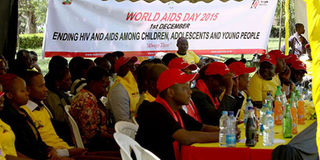Study reveals poor ARV response among children

World Aids Day commemoration in Nakuru on December 1, 2015. In Kenya, 93.2 per cent of HIV-positive children between the ages of 0 and 14 years are on antiretroviral drugs. PHOTO | FILE | NATION MEDIA GROUP
What you need to know:
- A majority of children living with HIV are infected via mother-to-child transmission during pregnancy, childbirth or breastfeeding.
- Dr Ngugi said children have a different immune response to HIV compared to adults as their bodies are constantly developing.
The country is doing badly as far as the reduction of the HIV viral load among children is concerned, says a new study whose results were released last Thursday.
While 93.2 per cent of HIV-positive children between the ages of 0 and 14 years are on antiretroviral drugs (ARVs), only 67.1 per cent had achieved viral load suppression (VLS).
VLS is when a person's viral load is down to an undetectable level. This, however, does not mean that the person is cured because HIV remains in the body and if medication is discontinued, the person’s viral load is likely to rise.
When a person living with HIV starts on an antiretroviral treatment (ART) regimen, their viral load drops.
For almost everyone who starts taking their HIV medication daily as prescribed, the viral load will drop to an undetectable level in six months or less.
MODERATING FACTORS
According to the 2018 "Kenya Population-Based HIV Impact Assessment" report, viral suppression stands at 67.1 per cent for the 0 to 14 age-group compared to 90.6 per cent for adults aged between 15 and 64, and 88.4 per cent for the general population.
“The prevalence of VLS among people living with HIV aged 0-64 years was generally higher among girls and women compared to boys and men across all the age groups. Among adults, women had a VLS of 74.6 per cent while men had 65.1 per cent,” states the study.
It continues: “The highest VLS prevalence was achieved among adults aged 55-64 years at 83.6 per cent. There was a decreased prevalence of VLS with decreasing age, with the lowest amongst children.”
Dr Catherine Ngugi, head of the National Aids and STI Control Programme (Nascop) told the Nation that the lower viral load suppression percentage in children was caused by many factors among them non-adherence, stigma and discrimination in school, failure by parents to disclose to their children their status and bitter drug formulations.
The survey conducted between June 2018 and February 2019 targeting 34,610 people revealed that despite the low VLS, the overall HIV prevalence among children was 0.7 per cent, which translates to 139,000 children.
“We are doing well as far as the identification of the young ones is concerned, but we tend to lose them at some point; that is why the virus is not reducing in their system,” Dr Ngugi said.
IMMUNE RESPONSE
HIV treatment for children works; unfortunately, there is a limited range of age-appropriate antiretroviral drugs that are available in paediatric formulations especially second or third-line alternatives, which makes treatment even more challenging, she added.
Palatability of drugs, for example, “can be complicated as some are tricky to swallow and can taste unpleasant,” the Nascop boss said.
And added that the volume of medicines recommended for children under the age of three is a challenge.
“Some of these medicines need to be kept cool, which can be an issue in some countries,” she said.
Dr Ngugi said children have a different immune response to HIV compared to adults as their bodies are constantly developing, and their high rate of metabolism makes the dosing of HIV medicines particularly difficult.
As such, paediatricians treating children growing up with HIV also need to be aware of special dosage instructions.
IMPROVE ADHERENCE
On average, infected patients living with HIV from childhood will have to take ARVs 20 years longer than people who acquire HIV as adults, which heightens adherence issues.
As more children are growing older with HIV, the inadequacies of healthcare services for older children are coming to light.
Dr Ngugi said that the US Food and Drug Administration gave tentative approval for an improved paediatric formulation in the form of small oral pellets it is hoped will improve adherence.
She added that late conveying of HIV status can affect treatment. “It’s important for parents and caregivers to disclose a child’s status to them to prevent them from feeling isolated and finding out their status accidentally or in public,” Dr Ngugi said.
There was also evidence that children who were told why they needed to take ARVs were more likely to have improved viral suppression, adherence and to remain on treatment for longer, she said.
Nascop chief officer Nduku Kilonzo challenged women to seek care in health facilities when they are expectant.
She said a majority of children living with HIV are infected via mother-to-child transmission during pregnancy, childbirth or breastfeeding.




